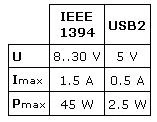Industrial Applications - FireWire or USB?
Published on August 1, 2008 by TIS Marketing.
 At first glance the difference between USB and FireWire cameras does not seem to be very big. However, regarding practical applications in areas such as security, engineering, science and medicine these little differences become a deciding factor:
At first glance the difference between USB and FireWire cameras does not seem to be very big. However, regarding practical applications in areas such as security, engineering, science and medicine these little differences become a deciding factor:
-
FireWire devices allow an operating voltage from 8 to 30 VDC. The current consumption may be 1.5 A. USB devices are much less flexible. The operating voltage has to be 4.7 VDC while the max current is 0.5 A.
-
FireWire devices hold their addresses after the system has been restarted while those of USB devices are reassigned. This is especially obstructive when using more than one camera.
-
There are more than 50 internationally standardized protocols for FireWire devices. In the case of cameras transferring their image data without compression or an audio channel the protocol is DCAM/IIDC. USB cameras, in comparison, only come with proprietary protocols.
The cause of these differences lie in their history. USB is the successor of the RS232 interface. FireWire is a user friendly variation of busses such as SCSI, PCI, etc. When only using one camera, the differences are not usually important. But, for more demanding applications the possibilities of USB are very limited.
